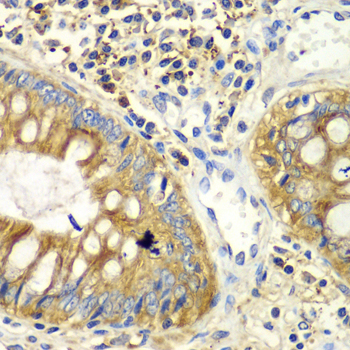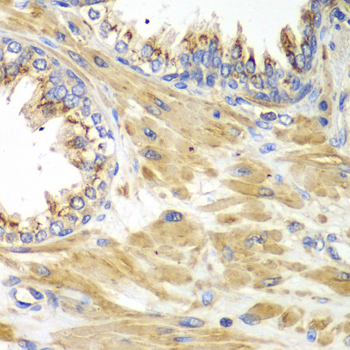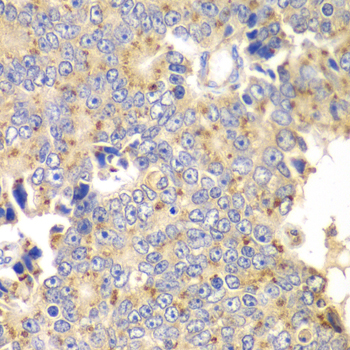-
Product Name
PICK1 Polyclonal Antibody
- Documents
-
Description
Polyclonal antibody to PICK1
-
Tested applications
IHC, IF
-
Species reactivity
Human
-
Alternative names
PICK1 antibody; PICK antibody; PRKCABP antibody; PRKCA-binding protein antibody
-
Isotype
Rabbit IgG
-
Preparation
Antigen: A synthetic peptide corresponding to a sequence within amino acids 260-360 of human PICK1 (NP_036539.1).
-
Clonality
Polyclonal
-
Formulation
PBS with 0.02% sodium azide, 50% glycerol, pH7.3.
-
Storage instructions
Store at -20℃. Avoid freeze / thaw cycles.
-
Applications
IHC 1:50 - 1:200
IF 1:50 - 1:200 -
Validations

Immunohistochemistry - PICK1 Polyclonal Antibody
Immunohistochemistry of paraffin-embedded human colon using PICK1 antibody at dilution of 1:100 (40x lens).

Immunohistochemistry - PICK1 Polyclonal Antibody
Immunohistochemistry of paraffin-embedded human prostate using PICK1 antibody at dilution of 1:100 (40x lens).

Immunohistochemistry - PICK1 Polyclonal Antibody
Immunohistochemistry of paraffin-embedded human prostate cancer using PICK1 antibody at dilution of 1:100 (40x lens).

Immunohistochemistry - PICK1 Polyclonal Antibody
Immunohistochemistry of paraffin-embedded human gastric cancer using PICK1 antibody at dilution of 1:100 (40x lens).

Immunofluorescence - PICK1 Polyclonal Antibody
Immunofluorescence analysis of HeLa cells using PICK1 antibody . Blue: DAPI for nuclear staining.
-
Background
Probable adapter protein that bind to and organize the subcellular localization of a variety of membrane proteins containing some PDZ recognition sequence. Involved in the clustering of various receptors, possibly by acting at the receptor internalization level. Plays a role in synaptic plasticity by regulating the trafficking and internalization of AMPA receptors. May be regulated upon PRKCA activation. May regulate ASIC1/ASIC3 channel. Regulates actin polymerization by inhibiting the actin-nucleating activity of the Arp2/3 complex; the function is competetive with nucleation promoting factors and is linked to neuronal morphology regulation and AMPA receptor (AMPAR) endocytosis. Via interaction with the Arp2/3 complex involved in regulation of synaptic plasicity of excitatory synapses and required for spine shrinkage during long-term depression (LTD). Involved in regulation of astrocyte morphology, antagonistic to Arp2/3 complex activator WASL/N-WASP function.
Related Products / Services
Please note: All products are "FOR RESEARCH USE ONLY AND ARE NOT INTENDED FOR DIAGNOSTIC OR THERAPEUTIC USE"
